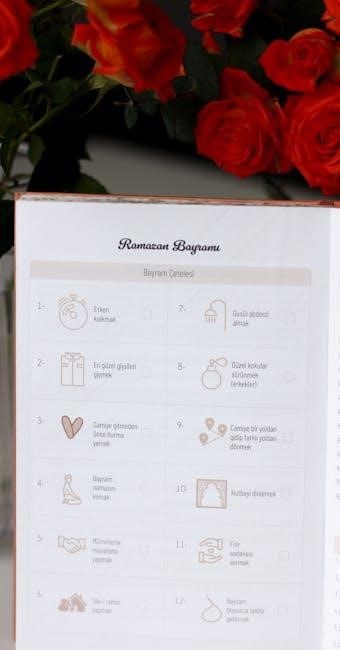The Bangladesh Arabic Guide PDF is a user-friendly resource designed to help learners master Arabic in Bangladesh․ It offers a clear, structured approach with practical tips and cultural insights, making it an essential tool for anyone interested in learning the language․
Whether you’re a beginner or an advanced learner, this guide provides comprehensive coverage of Arabic grammar, vocabulary, and cultural context, ensuring a holistic learning experience tailored to Bangladeshi learners․
Overview of the Guide’s Purpose and Structure
The Bangladesh Arabic Guide PDF is specifically designed to assist learners in Bangladesh in understanding and mastering the Arabic language․ Its primary purpose is to bridge the gap between traditional Arabic learning methods and the modern, practical needs of Bangladeshi students and professionals․ The guide is structured to cater to all levels of learners, from beginners to advanced students, ensuring a progressive and comprehensive learning experience․
The guide is divided into well-organized sections, each focusing on a specific aspect of the Arabic language, such as grammar, vocabulary, and cultural insights․ It also incorporates practical applications, including communication tips and travel guides, making it a versatile resource for both academic and real-world use․ By combining clear explanations, interactive exercises, and cultural context, the guide aims to make Arabic learning accessible, engaging, and effective for learners in Bangladesh․
Importance of Learning Arabic in Bangladesh
Learning Arabic in Bangladesh holds significant cultural, religious, and educational value․ As the language of the Quran, Arabic is essential for understanding Islamic teachings, which play a central role in the daily lives of many Bangladeshis․ Proficiency in Arabic enhances one’s ability to engage with religious texts, fostering a deeper spiritual connection․ Additionally, Arabic is a valuable skill in the global job market, particularly in fields like diplomacy, international relations, and Islamic studies․ In Bangladesh, where Arabic is taught in schools and madrasas, mastering the language can open doors to academic and career opportunities․ Furthermore, it bridges cultural gaps, enabling better communication with Arabic-speaking countries and fostering mutual understanding․ The Bangladesh Arabic Guide PDF serves as a vital resource in this journey, providing learners with the tools to acquire this important skill effectively․

Structure of the Bangladesh Arabic Guide PDF
The guide is organized into sections covering Arabic basics, grammar, vocabulary, cultural insights, and practical applications․ It provides a structured learning path for all levels, ensuring comprehensive understanding and application of the language․
The Arabic language, a cornerstone of Islamic culture, is widely studied in Bangladesh for its religious and academic significance․ This section of the guide provides an overview of Arabic’s historical background, its importance in Islamic traditions, and its relevance in Bangladesh․ It introduces learners to the basics of the language, including its unique script, pronunciation, and fundamental principles․ By understanding the origins and evolution of Arabic, learners can appreciate its role in shaping Islamic literature and its influence on the Bengali language․ This foundational knowledge prepares learners for further exploration of grammar, vocabulary, and practical applications, making it an essential starting point for anyone embarking on their Arabic learning journey in Bangladesh․

Basic Arabic Grammar and Syntax
This section of the Bangladesh Arabic Guide PDF delves into the fundamental rules of Arabic grammar and syntax, providing learners with a solid foundation to build upon․ It covers essential topics such as nouns, pronouns, and verbs, explaining their roles and functions in sentence construction․ The guide emphasizes the importance of understanding Arabic syntax, which differs significantly from other languages like Bengali․ Learners are introduced to concepts such as gender (masculine and feminine), number (singular, plural, and dual), and case endings, which are crucial for accurate communication․ Practical examples and exercises are included to help learners grasp these concepts effectively․ By mastering these basics, learners can construct grammatically correct sentences and improve their overall language proficiency․ This section is designed to be user-friendly, ensuring that even beginners can navigate the complexities of Arabic grammar with ease․
Common Arabic Vocabulary and Phrases
This section of the Bangladesh Arabic Guide PDF focuses on essential Arabic vocabulary and phrases, providing learners with the foundational language needed for effective communication․ It includes a wide range of common expressions, such as greetings, introductions, and basic conversational phrases, which are vital for everyday interactions․ The guide also covers practical vocabulary related to numbers, days of the week, and common objects, making it easier for learners to navigate real-life situations․ Additionally, it offers phrases for specific contexts like shopping, dining, and asking for directions, ensuring that learners can apply their knowledge in various scenarios․ The guide includes pronunciation guides and examples of usage, helping learners to understand and memorize the phrases more effectively․ By mastering these common Arabic expressions, learners can build a strong foundation for further language development and enhance their ability to communicate with Arabic-speaking communities, both locally and globally․

Cultural Insights in the Bangladesh Arabic Guide
This section explores the cultural significance of Arabic in Bangladesh, highlighting Islamic traditions, customs, and the language’s role in education and daily life, offering a deeper understanding of its cultural relevance․

Understanding Islamic Culture and Traditions

Understanding Islamic culture and traditions is essential for learners of Arabic in Bangladesh, as the language is deeply intertwined with Islamic practices․ The guide explores how Islamic traditions shape daily life, from prayer times to celebrations like Eid․ It highlights the significance of Arabic in religious contexts, such as reciting the Quran and understanding Hadiths․ The section also delves into the cultural practices unique to Bangladesh, blending Islamic values with local customs․ Learners gain insights into the role of Arabic in preserving Islamic heritage and its influence on Bengali language and culture; This knowledge enriches the learning experience, helping learners appreciate the cultural nuances of Arabic beyond mere language acquisition․ By understanding these traditions, learners can better connect with the Islamic community in Bangladesh and globally, fostering cultural awareness and appreciation․

Arabic Etiquette and Customs
Arabic etiquette and customs play a vital role in shaping interactions and social behaviors in Bangladesh, particularly among Muslim communities․ The guide highlights key aspects of Arabic customs, such as respect for elders, the importance of greetings like “Assalamu Alaikum,” and the use of the right hand in eating and giving/receiving items․ It also emphasizes modesty in attire and speech, reflecting the cultural values shared between Arabic and Bangladeshi traditions․ Learners are introduced to the significance of hospitality, a cornerstone of Arabic culture, and how to navigate social settings with grace․ The guide further explains the role of Arabic phrases in expressing politeness and respect, which are deeply ingrained in Islamic traditions․ By mastering these customs, learners can foster meaningful connections and demonstrate cultural sensitivity in both personal and professional interactions․ This section serves as a bridge between language learning and cultural understanding, enriching the overall experience of studying Arabic in Bangladesh․
The Role of Arabic in Bangladesh’s Education System
Arabic holds a significant position in Bangladesh’s education system, primarily due to its religious and cultural importance․ The language is integrated into the curriculum of both public and private schools, particularly in Islamic education institutions․ Many students pursue Arabic studies to gain a deeper understanding of the Quran and Islamic teachings․ The Bangladesh Arabic Guide PDF supports this educational framework by providing structured learning materials, including grammar, vocabulary, and cultural insights․ The guide aligns with the National Curriculum and Textbook Board (NCTB) guidelines, offering resources for students from Class 7 onwards․ Additionally, it caters to the needs of madrasa students, ensuring a comprehensive learning experience․ By emphasizing Arabic’s role in education, the guide bridges the gap between academic and religious learning, fostering a well-rounded understanding of the language and its cultural significance in Bangladesh․

Practical Applications of the Guide
The guide offers practical tools for real-life applications, enabling learners to use Arabic effectively for travel, communication, and cultural interactions in Bangladesh and beyond․
Arabic for Beginners: A Step-by-Step Approach
The guide provides a structured step-by-step approach for beginners, starting with the basics of Arabic script, pronunciation, and simple grammar rules․ It introduces essential vocabulary and phrases, enabling learners to build a strong foundation․ The manual includes interactive exercises and practical examples, making the learning process engaging and effective․ For Bangladeshi learners, the guide incorporates local context, ensuring the material is relatable and applicable to everyday life․ This section is designed to gradually progress learners from basic understanding to confident communication, making Arabic accessible and enjoyable for all․
Advanced Arabic Learning Techniques
The guide offers advanced techniques for learners aiming to master Arabic, focusing on refining language skills and deepening cultural understanding․ It explores complex grammar, nuanced vocabulary, and sophisticated sentence structures, enabling learners to engage with classical and modern Arabic texts confidently․ The section emphasizes immersion methods, such as engaging with Arabic media, literature, and authentic materials, to enhance fluency․ Additionally, it provides strategies for improving reading, writing, and speaking abilities through structured exercises and real-life applications․ For learners in Bangladesh, the guide incorporates advanced resources and references, ensuring a seamless transition from intermediate to proficient levels․ This section is tailored to meet the needs of serious learners seeking to achieve mastery in Arabic, bridging the gap between academic knowledge and practical application․
Using the Guide for Travel and Communication
The Bangladesh Arabic Guide PDF is an invaluable resource for travelers and communicators, offering practical tools to navigate Arabic-speaking environments․ It provides essential phrases, pronunciation guides, and cultural insights, enabling effective communication․ The guide includes sections on greetings, directions, and common interactions, making it perfect for travelers visiting Bangladesh or other Arabic-speaking regions․ Learners can quickly access phrases for dining, shopping, and emergencies, ensuring smooth interactions․ Additionally, the guide highlights cultural etiquette, helping users avoid misunderstandings and build rapport․ With its focus on real-life scenarios, the guide empowers learners to communicate confidently in Arabic, whether for travel, business, or personal connections․ Its user-friendly format allows for easy reference, making it a must-have companion for anyone seeking to enhance their Arabic communication skills in Bangladesh and beyond․
Download the guide to unlock a world of seamless Arabic communication and cultural understanding, tailored for Bangladeshi learners and travelers alike․

Additional Resources and References
The guide recommends supplementary materials like “Lessons in Arabic Language, Book 1” and online platforms for further learning․ It also lists community support groups for language exchange and practice․
Explore recommended books, online courses, and cultural resources to deepen your Arabic knowledge and connect with fellow learners in Bangladesh and beyond․
Recommended Arabic Learning Materials
For effective Arabic learning, the guide suggests several resources․ “Lessons in Arabic Language, Book 1” by Shaykh Dr․ V․ Abdur-Raheem is highly recommended for its comprehensive approach to grammar and syntax․ Additionally, the “Madinah Arabic Reader” series provides graded lessons ideal for beginners․ The “Arabic-Bangla Vocabulary Bank” is another valuable resource, offering essential phrases and words translated into Bengali for easier understanding․ Online platforms like “Arabic for Beginners: A Guide to Modern Standard Arabic” by Sarah Risha are also highlighted for supplementary learning․ These materials cater to all proficiency levels, ensuring a well-rounded learning experience․ They are easily accessible in PDF format, making it convenient for learners in Bangladesh to download and study at their own pace․
Online Platforms for Supplementary Learning

Supplement your Arabic learning journey with online platforms offering a wealth of resources․ The “Arabic for Beginners: A Guide to Modern Standard Arabic” by Sarah Risha is available for free download, providing a solid foundation for new learners․ Additionally, the “Madinah Arabic Reader” series and “Arabic-Bangla Vocabulary Bank” are accessible online, offering graded lessons and essential phrases in Bengali for easier comprehension․ Platforms like Z-Library and Fatwa-Online․Com host numerous Arabic learning materials, including PDF books and interactive guides․ These resources cater to all proficiency levels, from basic to advanced, ensuring a comprehensive learning experience․ They also provide flexibility, allowing learners to study at their own pace and access materials anytime, anywhere․ These online tools are invaluable for learners in Bangladesh, offering supplementary support to traditional study methods․
Community Support and Language Exchange Opportunities
Engaging with local communities and language exchange programs can greatly enhance your Arabic learning experience in Bangladesh․ Institutes like Abu Rayhan and Rayhans in Dhaka offer structured courses and cultural events, fostering a supportive environment for learners․ Community centers often organize Arabic language meetups, providing opportunities to practice with native speakers and enthusiasts․ Additionally, online forums and social media groups dedicated to Arabic learners in Bangladesh create platforms for sharing resources, asking questions, and collaborating on language projects․ These networks not only help improve language skills but also offer cultural insights and practical communication tips․ Participating in such communities can be incredibly motivating and enriching, making the learning process more enjoyable and effective․ By connecting with others, learners can gain confidence and refine their abilities in a collaborative setting․
